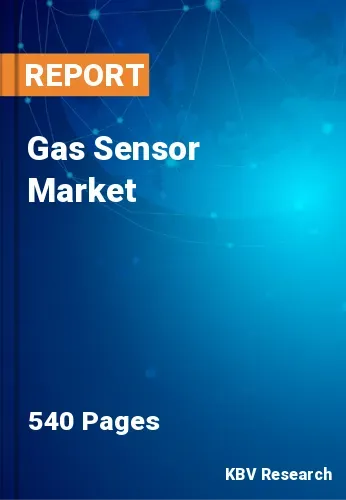The Global Gas Sensor Market size is expected to reach $3.5 billion by 2030, rising at a market growth of 9.4% CAGR during the forecast period. In the year 2022, the market attained a volume of 7,670.1 thousand units, experiencing a growth of 9.4% (2019-2022).
Infrared gas sensors suit various gases, including hydrocarbons, carbon dioxide, methane, and VOCs. This versatility makes them applicable in diverse industries, such as environmental monitoring, industrial safety, and emissions control. Therefore, the infrared (IR) segment captured $272.6 million revenue in the market in 2022. Infrared sensors provide accurate measurements of gas concentrations. Their ability to precisely quantify gas levels is crucial for applications where accuracy is paramount, such as in industrial process control and environmental compliance monitoring. Infrared sensors are less susceptible to interference from other gases in the environment.
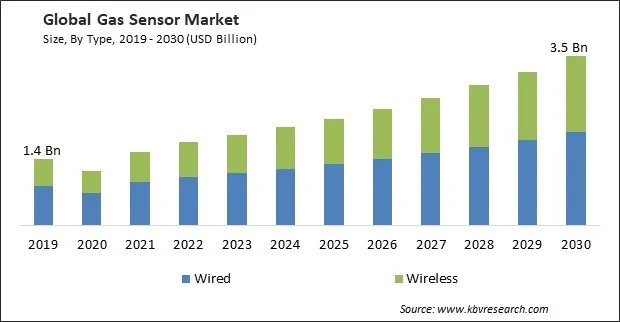
The major strategies followed by the market participants are Partnerships, Collaborations & Agreements as the key developmental strategy to keep pace with the changing demands of end users. For instance, In October, 2023, Siemens AG came into a partnership with Microsoft Corporation. Under this partnership, the Siemens Industrial Copilot, an AI-powered assistant used for improving collaboration between humans and machines, was introduced. In September, 2022, ABB Group came into a partnership with Samotics BV. Under this partnership, the Ability Condition Monitoring service for powertrains for ABB was integrated with the SAM4 technology of Samotics. Additionally, this partnership assisted in the asset health monitoring of motor-driven industrial equipment.
Based on the Analysis presented in the KBV Cardinal matrix; Tokuyama Corporation is the forerunners in the market. In September, 2021, Tokuyama Corporation formed a partnership with Panasonic Holdings Corporation, a Japanese multinational electronics company. Under this partnership, the companies used the hydrogen generated as a by-product in the manufacture of caustic soda and incorporated it into the pure hydrogen fuel cell generators. Additionally, the partnership achieved decarbonization in society and established hydrogen as a next-generation source of energy. Companies such as Honeywell International, Inc., Siemens AG, ABB Group are some of the key innovators in market.
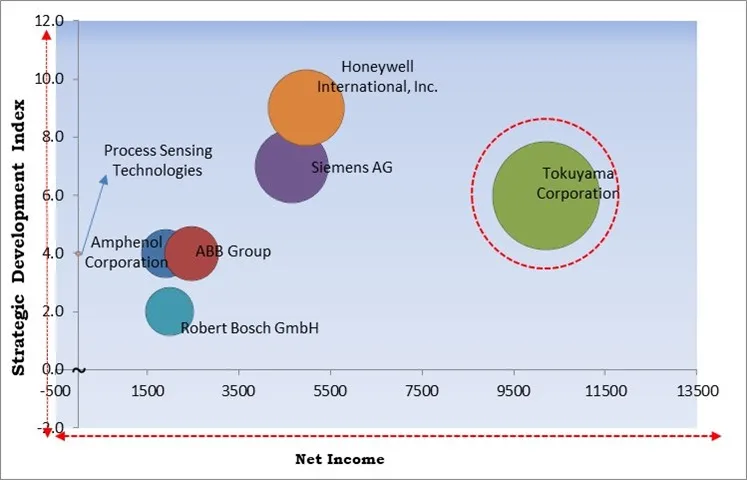
The growth of manufacturing and industrial activities globally drives the demand for gas sensors. These sensors are essential for monitoring various gases in industrial processes, ensuring safety, optimizing operations, and complying with environmental standards. The chemical and petrochemical industries involve the handling of various gases, some of which can be hazardous. These are crucial for monitoring gas concentrations during production processes, ensuring the safety of workers, preventing leaks, and optimizing production efficiency. The market is expanding significantly due to the increasing industrialization and manufacturing activities.
Integrating these with the IoT and Industry 4.0 initiatives enhances connectivity and data-sharing capabilities. IoT-enabled gas sensors facilitate remote monitoring and management. Users can access real-time data from sensors deployed in diverse locations, allowing for centralized control and monitoring. This is especially beneficial for industries with distributed operations and widespread sensor deployments. Integration with Industry 4.0 principles allows these to contribute to predictive maintenance strategies. As a result of the growing emergence of IoT and industry 4.0, the market is anticipated to increase significantly.
Harsh environmental conditions can affect the accuracy of gas sensors. Extreme temperatures or exposure to corrosive substances may alter the sensor's sensitivity and response characteristics, leading to inaccurate readings. This compromised accuracy can undermine the reliability of these in critical applications. Exposure to harsh conditions can accelerate sensor degradation, shortening the operational lifespan of these. This can result in increased maintenance costs and the need for more frequent replacements, especially in industrial settings with extreme environmental conditions. Harsh environmental conditions can slow down the growth of market.
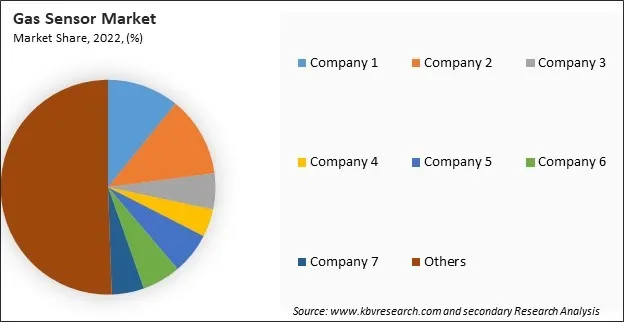
The leading players in the market are competing with diverse innovative offerings to remain competitive in the market. The above illustration shows the percentage of revenue shared by some of the leading companies in the market. The leading players of the market are adopting various strategies in order to cater demand coming from the different industries. The key developmental strategies in the market are Partnerships & Collaborations.
By type, the market is categorized into wired and wireless. The wireless segment covered a considerable revenue share in the market in 2022. Wireless gas sensors enable real-time monitoring of gas concentrations, providing timely data for decision-making and response. This is crucial in applications where rapid detection and response to changes in gas levels are essential for safety and operational efficiency. Installing wireless sensors is often quicker and involves less disruption than wired systems.
On the basis of product, the market is segmented into carbon dioxide (CO2) sensors, carbon monoxide (CO) sensors, oxygen (O2)/lambda sensors, nitrogen oxide (NOx) sensors, and others. In 2022, the carbon dioxide (CO2) sensors segment dominated the market with maximum revenue share. CO2 sensors are commonly used for monitoring indoor air quality. In commercial buildings, schools, offices, and residential spaces, these sensors help maintain optimal CO2 levels, ensuring a healthy and comfortable environment. As awareness of indoor air quality increases, the demand for CO2 sensors will likely grow.
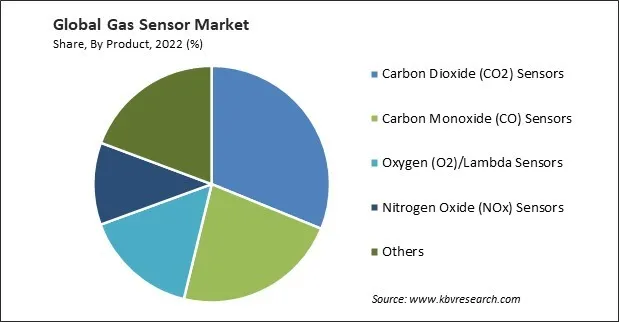
By technology, the market is fragmented into electrochemical, solid state/MOS, infrared (IR), catalytic, photo-ionization detector (PID), and others. The solid state/MOS segment recorded a remarkable revenue share in the market in 2022. Solid-state/MOS sensors are known for their high sensitivity to various gases. They can detect low concentrations of target gases, making them effective in applications where early detection is critical for safety and environmental protection. MOS sensors typically offer a fast response time, providing real-time data on changing gas concentrations.
Based on end user, the market is classified into industrial, environmental, medical, automotive, petrochemical, agriculture, building automation & domestic appliances, and others. In 2022, the industrial segment witnessed the largest revenue share in the market. These are integral to industrial processes, providing real-time data on gas concentrations that can impact production efficiency. By monitoring and controlling gas levels, industries can optimize processes, improve product quality, and minimize waste. Industrial facilities, particularly those handling hazardous materials, deploy these for leak detection.
| Report Attribute | Details |
|---|---|
| Market size value in 2022 | USD 1.7 Billion |
| Market size forecast in 2030 | USD 3.5 Billion |
| Base Year | 2022 |
| Historical Period | 2019 to 2021 |
| Forecast Period | 2023 to 2030 |
| Revenue Growth Rate | CAGR of 9.4% from 2023 to 2030 |
| Number of Pages | 540 |
| Number of Tables | 1053 |
| Quantitative Data | Volume in Thousand Units, Revenue in USD Billion, and CAGR from 2019 to 2030 |
| Report coverage | Market Trends, Revenue Estimation and Forecast, Segmentation Analysis, Regional and Country Breakdown, Competitive Landscape, Market Share Analysis, Porter’s 5 Forces Analysis, Company Profiling, Companies Strategic Developments, SWOT Analysis, Winning Imperatives |
| Segments covered | Type, Product, Technology, End User, Region |
| Country scope |
|
| Companies Included | Siemens AG, Robert Bosch GmbH, Amphenol Corporation, ABB Group, GfG Gesellschaft für Gerätebau mbH, Honeywell International, Inc., Dragerwerk AG & Co. KGaA, Process Sensing Technologies, Tokuyama Corporation, and Nemoto & Co.,Ltd.< |
| Growth Drivers |
|
| Restraints |
|
Region-wise, the market is analysed across North America, Europe, Asia Pacific, and LAMEA. In 2022, the Asia Pacific region led the market by generating the highest revenue share. The manufacturing industry in the Asia-Pacific region is experiencing substantial expansion and is rapidly industrializing. These are in high demand in nations such as China, India, Japan, and South Korea because of their use in the petrochemical, electronics, automotive, and chemical industries. The automotive sector has a significant hub in the Asia Pacific region.
Free Valuable Insights: Global Gas Sensor Market size to reach USD 3.5 Billion by 2030
The market research report covers the analysis of key stake holders of the market. Key companies profiled in the report include Siemens AG, Robert Bosch GmbH, Amphenol Corporation, ABB Group, GfG Gesellschaft für Gerätebau mbH, Honeywell International, Inc., Dragerwerk AG & Co. KGaA, Process Sensing Technologies, Tokuyama Corporation, and Nemoto & Co.,Ltd.
By Type (Volume, Thousand Units, USD Billion, 2019-2030)
By Product (Volume, Thousand Units, USD Billion, 2019-2030)
By Technology (Volume, Thousand Units, USD Billion, 2019-2030)
By End User (Volume, Thousand Units, USD Billion, 2019-2030)
By Geography (Volume, Thousand Units, USD Billion, 2019-2030)


This Market size is expected to reach $3.5 billion by 2030.
Increasing industrialization and manufacturing activities are driving the Market in coming years, however, Harsh environmental conditions restraints the growth of the Market.
Siemens AG, Robert Bosch GmbH, Amphenol Corporation, ABB Group, GfG Gesellschaft für Geratebau mbH, Honeywell International, Inc., Dragerwerk AG & Co. KGaA, Process Sensing Technologies, Tokuyama Corporation, and Nemoto & Co.,Ltd.
The expected CAGR of this Market is 16.4% from 2023 to 2030.
The Wired segment is capturing maximum revenue in the Market by Type in 2022; thereby, achieving a market value of $1.9 billion by 2030.
The Asia Pacific region dominated the Market by Region in 2022 and would continue to be a dominant market till 2030; thereby, achieving a market value of $1.2 billion by 2030.
Our team of dedicated experts can provide you with attractive expansion opportunities for your business.
